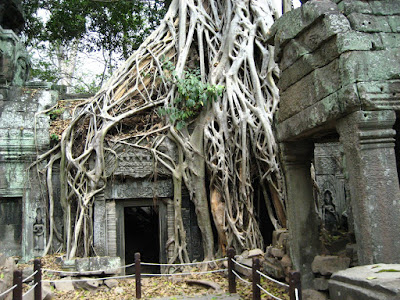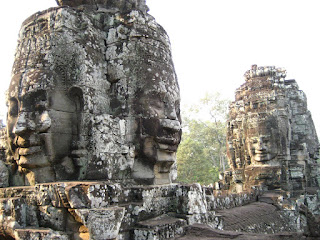Angkor encore!
 Well here I am bretheren, in the hot Cambodian jungle. Or at least, the place that until quite recently was the Cambodian jungle. Now it is the site of what must be the most flourishing building trade in the entire country, with hotels popping up like over-sized examples of totally new and garishly luxurious mushrooms along the roadside to the temple area.
Well here I am bretheren, in the hot Cambodian jungle. Or at least, the place that until quite recently was the Cambodian jungle. Now it is the site of what must be the most flourishing building trade in the entire country, with hotels popping up like over-sized examples of totally new and garishly luxurious mushrooms along the roadside to the temple area.The set-up is this: there is the town, Siem Reap, a village ballooned into a town through the recent mass tourism; a place where you have to haggle with tuk-tuk drivers ferociously for a fair price, a place where you can get an interesting array of massages with or without herbal oils for just a few dollars, a place with just one reason to exist: the Angkor temples.
Once upon a time (around a thousand years ago) there was this righteous dude, who named himself god-king (couldn't make his mind up which was better I suppose). This righteous dude Jayavarman II was followed by generations of god-kings, whose names all ended with ...varman. Somewhere along the way these ...varman dudes honoured their mothers and fathers and war victories and deaths of sons etc. by building great temples to them.
All the ...varman dudes seemed to be highly religious, judging by the motifs of the temples. Their religion seemed, however, to concentrate on the theme of the Apsaras (heavenly nymphs or divine dancing girls, who await the Khmer heroes (and god-kings) in the afterlife with the sole purpose of entertaining them with song, dance and never-ending sex. The Koran offers just 13 pale virgins for the enjoyment of its martyrs (or pale raisins according to some recent translations of the ancient Koran, which claim virgins was just a latter-day typo), but Khmer king-gods were not that stingy. Apsaras unlimited! As a result, the figures on the temples are predominantly female, as scantily clad voluptuous Apsaras outnumber other religious figures by about six to one.

The name Angkor Wat is rather mistakenly used for the whole area, as Angkor Wat is only one, albeit the largest and best known, of the many temples in the area. However it is not my favourite, since its fame means it bears the brunt of the ills of mass tourism - manicured lawns, rows of food stalls, tour groups and such. It is impossible to imagine oneself as Indiana Jones alone in the dark heart of the jungle on a perilous mission, when juggling for space among Korean tour groups and clung to by dozens of children touting Angkor guidebooks, bead bracelets, picture postcard sets or bottles of water - all of which items seem to cost the uniform and unimaginative price of 1 dollar!
Though luckily the going gets better at the other temples, it must be said: I really wish I had been here 20 years ago! It must have been amazing! Now it's just all a bit organized with tourists shuttled like cattle into waiting over-priced tuk-tuks, refreshed on the way by the proffed cold drinks, decorated with dozens of attractive new bangles, wearing Angkor Wat T-shirts and carrying spanking new Angkor guides (just one dollar madam).
It's truly sad, but the human mind is built to fathom the world by categorizing thing to understand them - and this means comparing things to others be able to categorize them. So, though I truly wish I could be a tabula rasa and look at the world with new eyes, I must admit that it doesn't always work. So I find myself thinking that Angkor is not as much a jungle paradise as Tikal in Guatemala, has architecture, which reminds me of Ayutthayah in Thailand, and has not got any place as good for watching the sun rise/set as there was over the temples as Bagan in Myanmar. Nor does it for the most part have the beautiful statues of Bagan. Sadly the statues of Angkor are mostly headless torsos - hopefully my telepahtic hate-wave will hit some millionaires in Rio de Janeiro, Beijing, Moscow, New York... wherever the heads of these statues may currently reside, and give them a bad case of the piles! Oh, and Angkor is not as big as the great wall of China... But fear not, all if not lost! Now on to the good stuff...
One thing Angkor excells in is the carvings. Luckily they are harder to steal, so they still exist and mostly in a good state of repair. Fantastic life-like detail where a huge army of soldiers will march on by (towards a heros fate with Apsaras and heaven) with every soldiers face and expression looking different. There are also amusing life-like elephants surrounded by Apsaras. And depictions of heaven and hell with people in hell being tortured in a variety of ways, which would not put Guantanamo to shame and people in hell being pampered by Apsaras.
Another thing which Angkor excells in is roots. Here there are some amazing examples of the symbiotic relationship of old stones and old trees. I'm not sure if the stones are supporting the trees or the trees supporting the stones at times. A good example of this can be seen at the "Tomb Raider"-temple Ta Prohm of movie fame (see the first photo for evidence).
It's truly sad, but the human mind is built to fathom the world by categorizing thing to understand them - and this means comparing things to others be able to categorize them. So, though I truly wish I could be a tabula rasa and look at the world with new eyes, I must admit that it doesn't always work. So I find myself thinking that Angkor is not as much a jungle paradise as Tikal in Guatemala, has architecture, which reminds me of Ayutthayah in Thailand, and has not got any place as good for watching the sun rise/set as there was over the temples as Bagan in Myanmar. Nor does it for the most part have the beautiful statues of Bagan. Sadly the statues of Angkor are mostly headless torsos - hopefully my telepahtic hate-wave will hit some millionaires in Rio de Janeiro, Beijing, Moscow, New York... wherever the heads of these statues may currently reside, and give them a bad case of the piles! Oh, and Angkor is not as big as the great wall of China... But fear not, all if not lost! Now on to the good stuff...
One thing Angkor excells in is the carvings. Luckily they are harder to steal, so they still exist and mostly in a good state of repair. Fantastic life-like detail where a huge army of soldiers will march on by (towards a heros fate with Apsaras and heaven) with every soldiers face and expression looking different. There are also amusing life-like elephants surrounded by Apsaras. And depictions of heaven and hell with people in hell being tortured in a variety of ways, which would not put Guantanamo to shame and people in hell being pampered by Apsaras.
Another thing which Angkor excells in is roots. Here there are some amazing examples of the symbiotic relationship of old stones and old trees. I'm not sure if the stones are supporting the trees or the trees supporting the stones at times. A good example of this can be seen at the "Tomb Raider"-temple Ta Prohm of movie fame (see the first photo for evidence).

Some temples (notably the Bayon temple) and bridge gates also have huge faces staring at all four winds from the tops of their lotus bud -shaped cupolas. I also enjoyed visiting some lesser temples far from the maddening crowds, with trees clinging onto them for dear life, crickets screeching in the foliage like some wine-glass shattering sopranos and weird furry looking fruit falling from equally odd trees. There are still pockets of jungle magic left out here.
No, it's not the Angkor or 20 years ago, but it's still worth seeing!


Comments